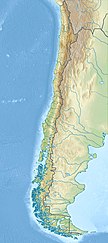Giant Magellan Telescope
 Artwork of Giant Magellan Telescope | |
| Alternative names | GMT |
|---|---|
| Part of | US Extremely Large Telescope Program |
| Location(s) | Las Campanas Observatory, Chile |
| Coordinates | 29°01.7′S 70°41.15′W / 29.0283°S 70.68583°W |
| Organization | GMT Consortium |
| Altitude | 2,516 m[1][2] |
| Wavelength | 320–25000 nm[3] |
| Built | Awaiting funding |
| Telescope style | Gregorian |
| Diameter | 25.448 m[4] |
| Secondary diameter | 3.2 m (10 ft 6 in) |
| Mass | 2,100 t (2,100,000 kg) |
| Angular resolution | 0.21–0.3″ at 500 nm[3] |
| Collecting area | 368 m²[4] |
| Focal length | 18.000 m (M1) 202.745 m (M1+M2)[4] |
| Mounting | altitude/azimuth |
| Website | http://www.gmto.org/ |
| | |
The Giant Magellan Telescope (GMT) is a ground-based telescope planned for completion in 2018. It will consist of seven 8.4 m (27.6 ft) diameter primary segments,[5] with the resolving power of a 24.5 m (80.4 ft) primary mirror and collecting area equivalent to 21.4 m (70.2 ft) one.[6] The telescope is expected to have over four times the light-gathering ability of existing instruments.
Planned site
The confirmed location of the telescope will be the Las Campanas Observatory,[7] which is also the site of the Magellan telescopes, some 115 km (71 mi) north-northeast of La Serena, Chile. Much as for previous notable telescopes, the site has been chosen as the new instrument's location because of its clear weather throughout most of the year.[8] Moreover, due to the sparsity of population centers and other favorable geographical conditions, the night sky in most of the surrounding Atacama Desert region is not only free from atmospheric pollution, but in addition it is probably one of the places least affected by light pollution, making the area one of the best spots on Earth for long-term astronomical observation.
Design peculiarities
The telescope is unique in that it will use seven mirror segments, each 8.4 m (27.6 ft) in diameter. These segments will then be arranged to form a single optical surface. The challenge in this is that the surface of the outer six mirror segments is not radially symmetrical (i.e. they are off-axis), necessitating a slight modification of the usual polishing procedure. Although the outer six mirrors will individually be off-axis, the design calls for the mirrors to be arranged so that the reflecting surface of all seven mirrors as a whole is on-axis, with one mirror in the center and the other six arranged symmetrical around the center, giving a focal plane on-axis with the entire assembly. The intention is to build seven identical off-axis mirrors, so that a spare is available to substitute for a segment being recoated, a 1–2 week (per segment) process required every 1–2 years.[9]
The mirrors are being constructed by the Steward Observatory at the University of Arizona, at a laboratory beneath the university's football stadium. The casting of the first mirror, in a rotating furnace, was completed on November 3, 2005, but the time-consuming shaping and polishing will be completed in early 2010.
The telescope will make use of adaptive optics.[10]
Organizations
The following is a list of the members of a consortium developing the telescope.[11]
- Observatories of the Carnegie Institution of Washington (OCIW)
- Harvard University
- Smithsonian Astrophysical Observatory
- Texas A&M University
- University of Arizona
- University of Texas at Austin
- Australian National University
- Astronomy Australia Limited
- Korea Astronomy and Space Science Institute
See also
- La Serena, Chile
- Magellan telescopes
- Atacama Desert
- Las Campanas Observatory
- Extremely Large Telescope
- List of largest optical reflecting telescopes
- Gran Telescopio Canarias
References
- ^ José Terán U.; Daniel H. Neff; Matt Johns (2006-05-29). "SPIE 6267: Symposium on Astronomical Telescopes and Instrumentation". Orlando, FL: SPIE. p. 2. Retrieved 2008-03-31.
{{cite web}}:|contribution=ignored (help) - ^ Joanna Thomas-Osip (2007-03-20). "Syposium on Seeing". Kona, HI: AAS. p. 3. Retrieved 2008-03-31.
{{cite web}}:|contribution=ignored (help) - ^ a b "Giant Magellan Telescope Science Requirements" (PDF). GMT Consortium. Retrieved 2008-03-31.
- ^ a b c "Chapter 6: Optics". GMT Conceptual Design Report. GMT Consortium. p. 6–3. Retrieved 2008-04-02.
{{cite book}}: External link in|chapterurl=|chapterurl=ignored (|chapter-url=suggested) (help) - ^ "Giant Magellan Telescope Partner Institutions". GMT Consortium. Retrieved 2007-04-03.
- ^ Maggie McKee (2007-10-04). "Giant telescope in race to become world's largest". New Scientist. Retrieved 2007-10-07.
- ^ "Giant Magellan telescope site selected". Carnegie Institution. Retrieved 2007-10-05.
- ^ Robinson, Travis (2007-04-03). "Eye on the sky". The Battalion. Retrieved 2007-04-03.
- ^ "Telescope Structure". GMT Conceptual Design Report. 2006. Retrieved 2007-10-07.
{{cite book}}: External link in|chapterurl=|chapterurl=ignored (|chapter-url=suggested) (help); Unknown parameter|month=ignored (help) Section 7.4.5, page 7-17. - ^ "GMT Overview Chapter 2" (PDF).
- ^ "Giant Magellan Telescope Partner Institutions". GMTO. Retrieved 2009-02-11.

